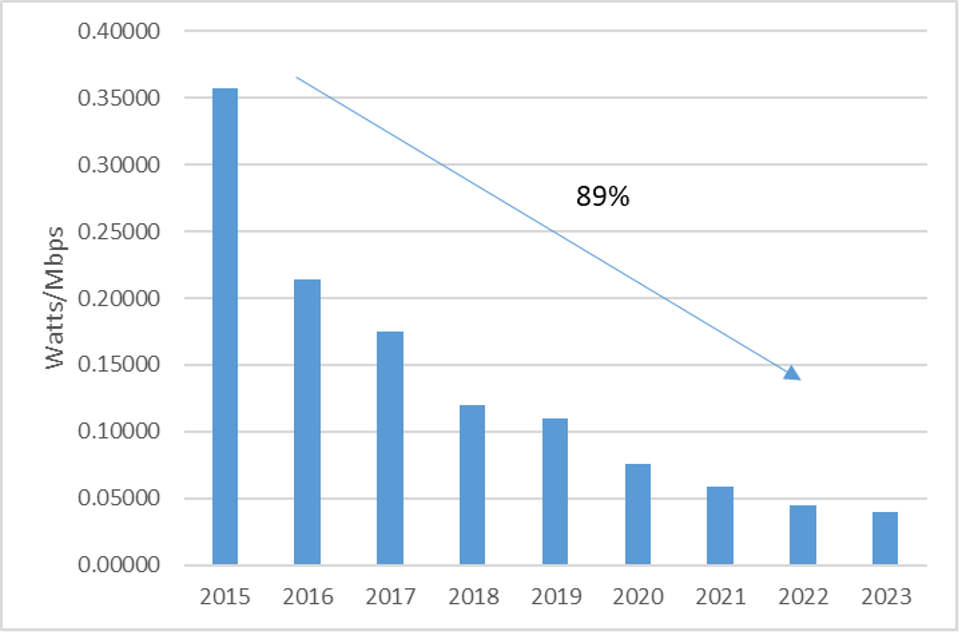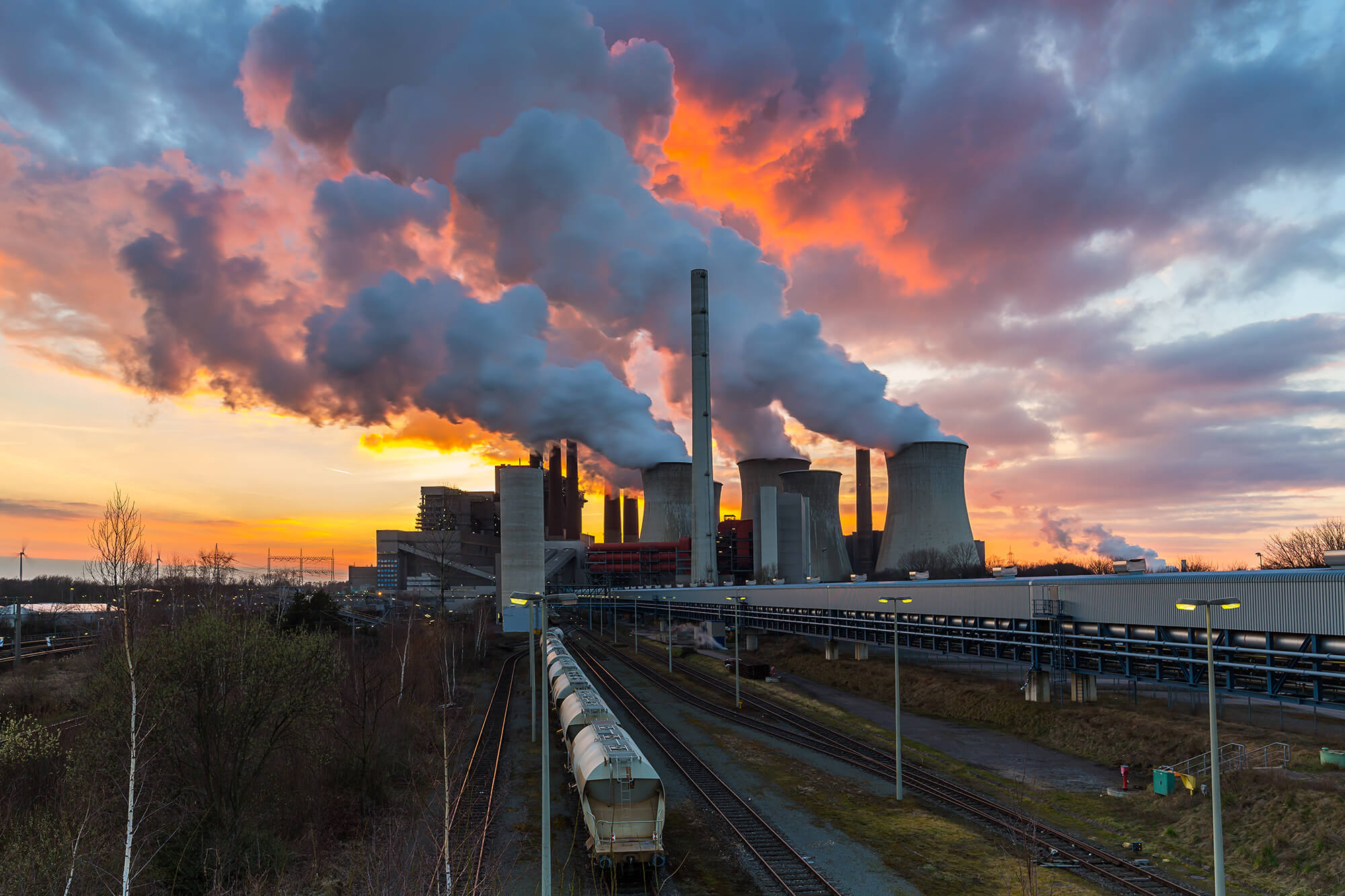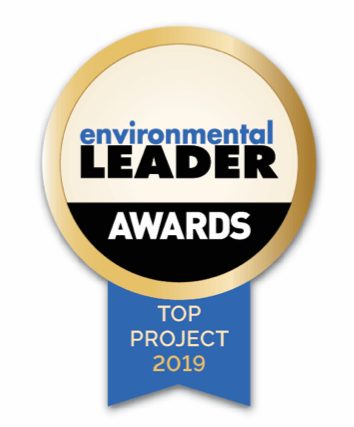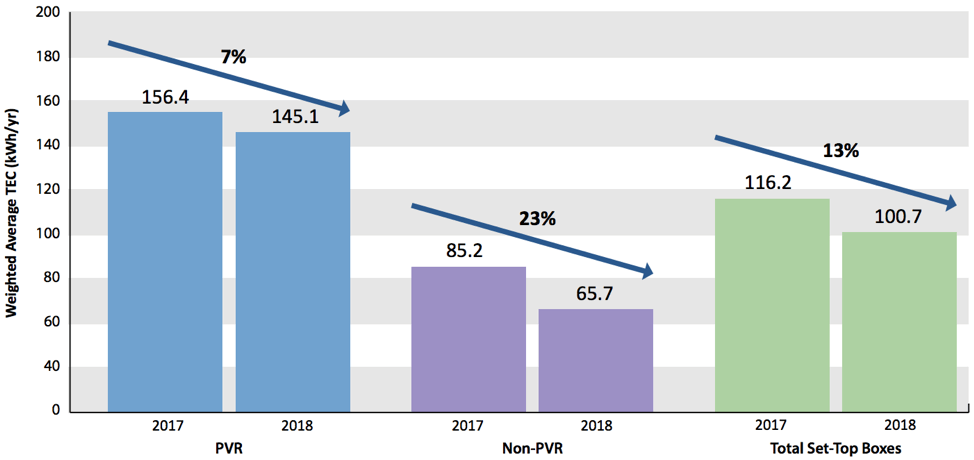Energy
Driving Efficiency at Scale With TV Set-Top Boxes and Internet Devices
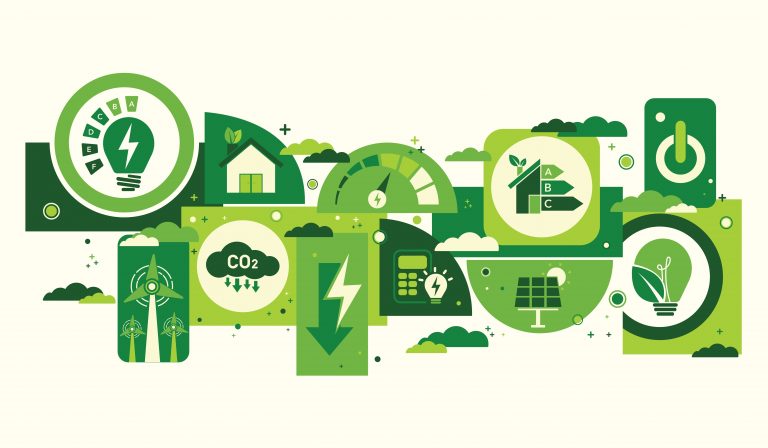
Key Points
- The voluntary agreements continue to deliver measurable energy efficiency improvements in set-top boxes and home networking equipment as shown in the most recent annual reports.
- The U.S. agreements have been extended through 2028, and the network equipment scope is expanded to include Fixed Wireless Access equipment with T-Mobile as a new signatory.
When people think about fighting climate change, they may picture solar panels on rooftops or wind turbines on hillsides. What’s less obvious is the quiet revolution happening inside our homes — through the very devices that connect us to TV and the internet.
Three new reports from the United States and Canada tell a clear story: The everyday set-top boxes and network gear we rely on are getting considerably more efficient, cutting energy usage while keeping pace with our growing digital appetites.
Efficiency Alongside Innovation
The 2024 U.S. Small Network Equipment (SNE) Report shows how internet gateways, routers and modems — the invisible workhorses of the broadband era — are becoming far more efficient. In 2024, nearly 99% of new devices met the latest Tier 3 energy levels, far surpassing the 90% commitment under the industry’s voluntary agreement.
That achievement is striking given what these devices now do. Today’s SNE is expected to support blazing-fast internet speeds, stronger Wi-Fi signals and the growing number of connected gadgets in our homes. Naturally, those features demand more power. Yet the data shows that manufacturers and providers are finding ways to deliver these capabilities without a proportional surge in energy use.
Perhaps the most telling metric is efficiency relative to broadband speed: Since 2015, the average energy use per unit of internet speed delivered has dropped by 89%. In other words, the boxes in our living rooms and home offices are working harder than ever, but they’re doing it more efficiently.
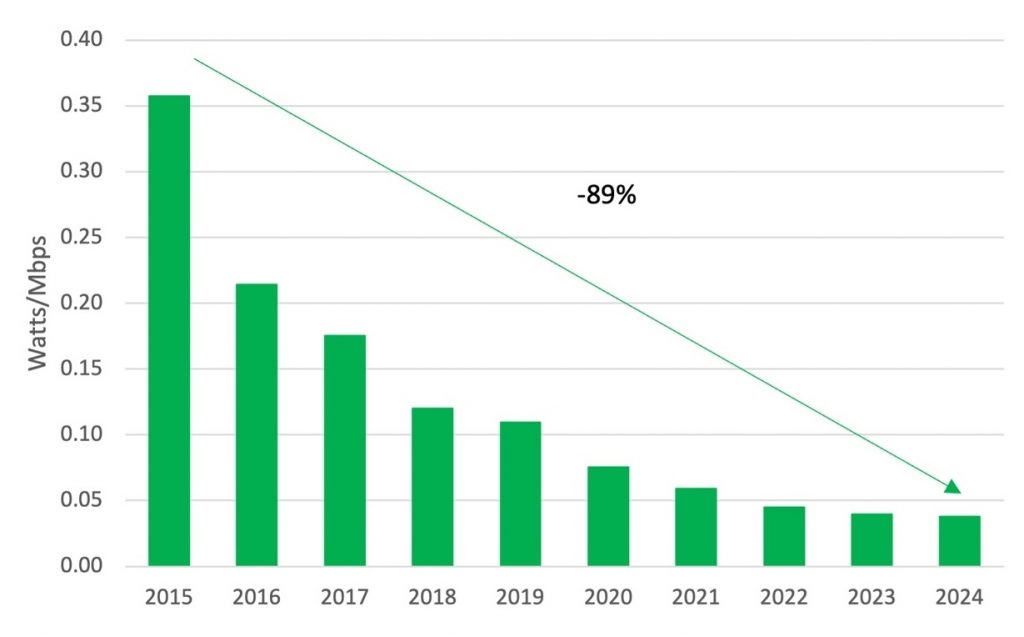
Weighted Average Ready State Power of New SNE Purchases Relative to Broadband Speeds
Set-Top Box Energy Consumption Continues to Improve
If SNE is the silent partner of the digital home, set-top boxes are the more visible face of our entertainment. The 2024 U.S. Set-Top Box (STB) Report paints an equally successful picture. Back in 2012, digital video recorders (DVRs) were notorious power hogs. But as of 2024, the landscape looks radically different.
- National energy use from set-top boxes has dropped 73%, falling from 32 terawatt-hours in 2012 to just 8.6 TWh in 2024.
- That reduction is the equivalent of shutting down eight traditional 500-megawatt power plants for a year.
- It also equates to a $3.85 billion reduction in electricity costs and avoidance of 15.7 million metric tons of CO2 emissions in 2024 compared to 2012.
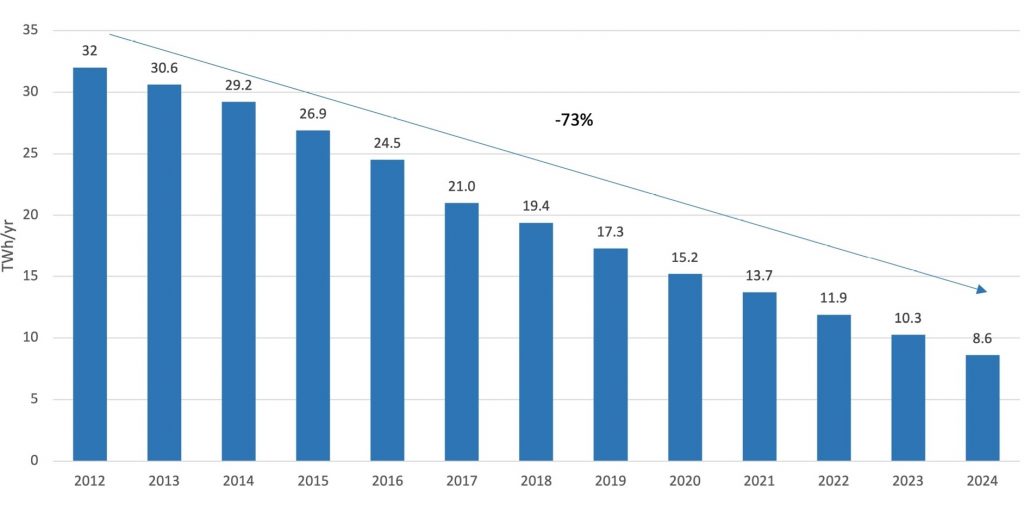
Nationwide Annual Energy Used by Set-Top Boxes in the U.S.
The reasons are twofold. First, service providers are deploying fewer set-top boxes overall, as more households switch to streaming services that don’t require them. But second — and just as importantly — the devices themselves are far more efficient. Today’s most common model, the IP-based non-DVR, uses only 26.6 kWh/year, a 78% drop compared to typical set-top boxes from a decade earlier.
Even DVRs now consume less than half the power they did when the agreement began. And for many households, cloud DVR services eliminate the need for a DVR altogether.
The Trends Continue in Canada Too
In Canada, the Canadian Energy Efficiency Voluntary Agreement (CEEVA) shows steady progress in improving the efficiency of set-top boxes and small network equipment.
According to the most recent 2024 independent annual report, 100% of new set-top boxes and 100% of small network equipment purchased met efficiency targets, surpassing the required 90%. This success reflects ongoing collaboration between service providers and manufacturers to deliver devices that use less energy while supporting modern broadband and TV services.
The data shows meaningful progress:
- Since 2017, the energy consumption of new set-top boxes in Canada has dropped 74%:
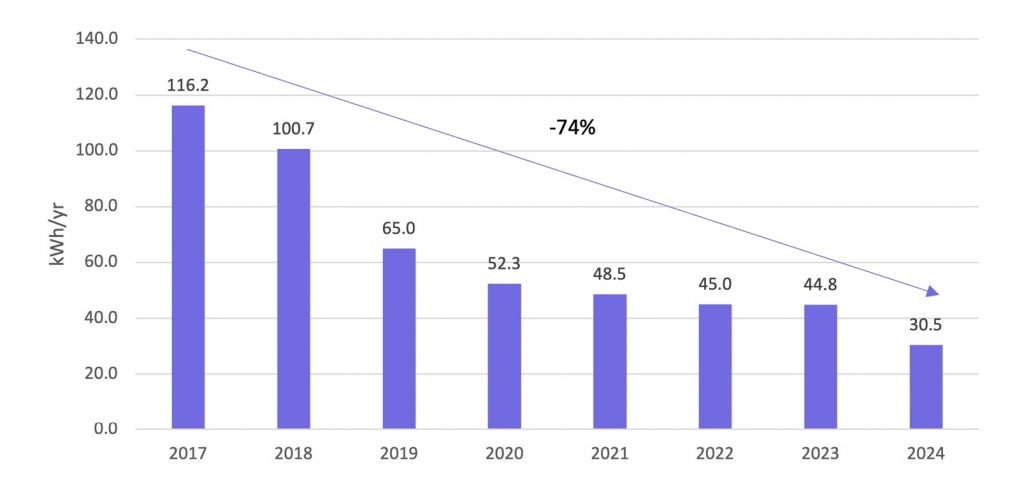
Weighted Average Energy Consumption of Purchased Set-Top Boxes
- Since 2020, the efficiency of small network equipment in Canada has improved 64% relative to broadband speed.
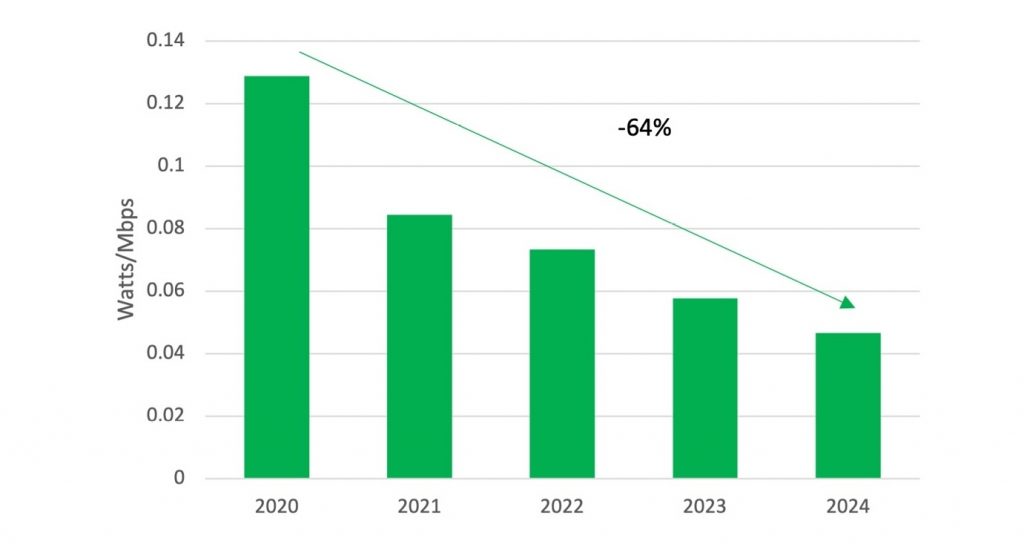
Weighted Average Energy Usage of New SNE, Relative to Broadband Download Speed
These impressive declines lower household energy use while maintaining the quality of service customers expect.
Continuing the Commitments
The signatories of these voluntary agreements are committed to continued success. Just recently, both the U.S. STB and SNE VAs extended their terms through 2028 with reports in 2029. More importantly, the SNE VA expanded the VA scope to include fixed wireless access (FWA) devices, increasing the residential market coverage by 13 million more subscribers, and added T-Mobile as a signatory.
The U.S. STB Voluntary Agreement brings together the largest pay-TV providers, manufacturers and energy efficiency advocate ACEEE (American Council for an Energy-Efficient Economy). Similarly, the SNE Voluntary Agreement includes the leading residential internet providers, major equipment manufacturers and Pacific Gas and Electric Company (PG&E) as the efficiency advocate. In Canada, CEEVA signatories include the country’s largest internet and pay-TV service providers and key manufacturers in close collaboration with Natural Resources Canada (NRCan).
CableLabs provides the technical leadership behind the voluntary agreements, working in close partnership with the Consumer Technology Association (CTA) and NCTA – The Internet & Television Association to deliver these measurable results.
Signatories
| U.S. STB VA | U.S. SNE VA | CEEVA |
| ACEEE, Altice USA, AT&T, AT&T/DIRECTV, Charter, Comcast, Cox, DISH Network, Frontier, Verizon, Sagemcom, Vantiva | Pacific Gas and Electric Company, Altice USA, AT&T, Charter, Comcast, Cox, Frontier, Verizon, Actiontec Electronics, ASUS, eero, Google, Linksys USA, Netgear, Plume, Sagemcom Broadband, TP-Link, Ubee Interactive, Vantiva | Bell Canada, Cogeco, Rogers, TELUS, Vidéotron, Echostar Technologies, Vantiva |
Why It Matters
Energy efficiency in household electronics doesn’t make headlines the way solar farms do. But the cumulative effect is enormous. Collectively, these voluntary industry agreements have prevented billions of dollars in electricity usage and eliminated hundreds of millions of metric tons of CO2 emissions. They’ve also shown that efficiency and innovation can go hand-in-hand: faster broadband, sharper video, and smarter networks don’t have to mean higher utility bills.
As we spend more time streaming, gaming, and connecting, it’s worth remembering that the invisible progress inside our routers and set-top boxes is part of the bigger climate solution. These improvements underscore how voluntary agreements can drive efficiency gains without compromising performance.
You can read more about energy efficiency on our blog and learn more about the voluntary agreements for the U.S. and Canada.
Energy
Gold Medal Efficiency: Energy Wins Add Up for Voluntary Agreement Programs

Key Points
- Energy-efficiency voluntary agreements aim to balance the energy consumption of home networking equipment with ever-increasing demands for faster, more reliable and more secure services.
- Annual reports reveal that, since their inception, voluntary agreement programs in the United States and Canada have resulted in considerable energy savings.
Just as our athletes strived for gold this summer at the Paris Olympics, our industry is striving for peak energy efficiency with home networking equipment and set-top boxes (STBs). The annual reports for energy-efficiency voluntary agreements were recently released, and it feels like these programs are setting new world records every year!
The Balance Beam
The Small Network Equipment Voluntary Agreement (SNE VA) is an initiative that addresses SNE devices such as modems and routers. It strives to balance energy consumption with the ever-evolving demand for faster downloads, better Wi-Fi coverage, increased security and reliability. The U.S. 2023 SNE VA Annual Report reveals that the energy efficiency of products purchased or sold in 2023 has improved by 89 percent since the program began.
These figures were calculated by dividing the weighted average power of devices purchased or sold each year by the mean fixed wireline consumer broadband download speed for each year as measured by Ookla.
The High Dive
The energy consumption of STBs continues to dive lower. According to the most recent STB VA Annual Report, the national footprint energy consumption of set-top boxes has plunged from 32 terawatt-hours per year (TWh/year) to 10.3 TWh/year over the course of the program!
The 21.7 TWh savings in 2023 equates to over $3.4 billion in savings to consumers and 15.2 million metric tons of CO2 avoided. The energy saved during the 11-year period is more than enough to power every home in California, Oregon and Nevada for a year.
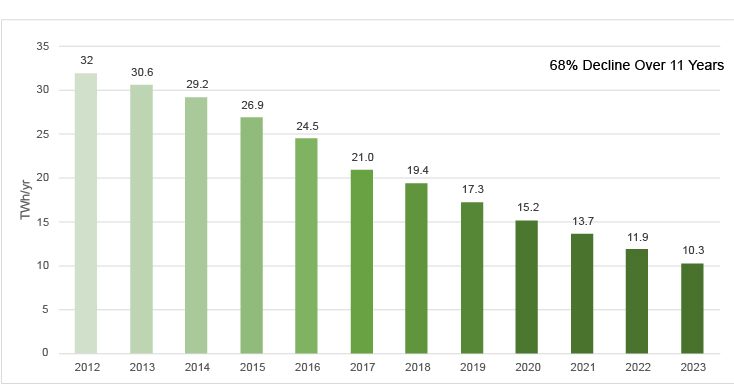
Energy consumption of set-top boxes has declined 68 percent since 2012.
Synchronized Diving
Canada is in sync with the U.S. in its energy efficiency programs, too. The Canadian Energy Efficiency Voluntary Agreement (CEEVA) 2023 Annual Report covers both STBs and SNE devices, and demonstrates nearly identical efficiency trends over the years.
The CEEVA program expanded the team when it added TELUS as a signatory this year, raising the market coverage of the CEEVA signatories to over 96 percent of both the pay TV and residential broadband markets in Canada.
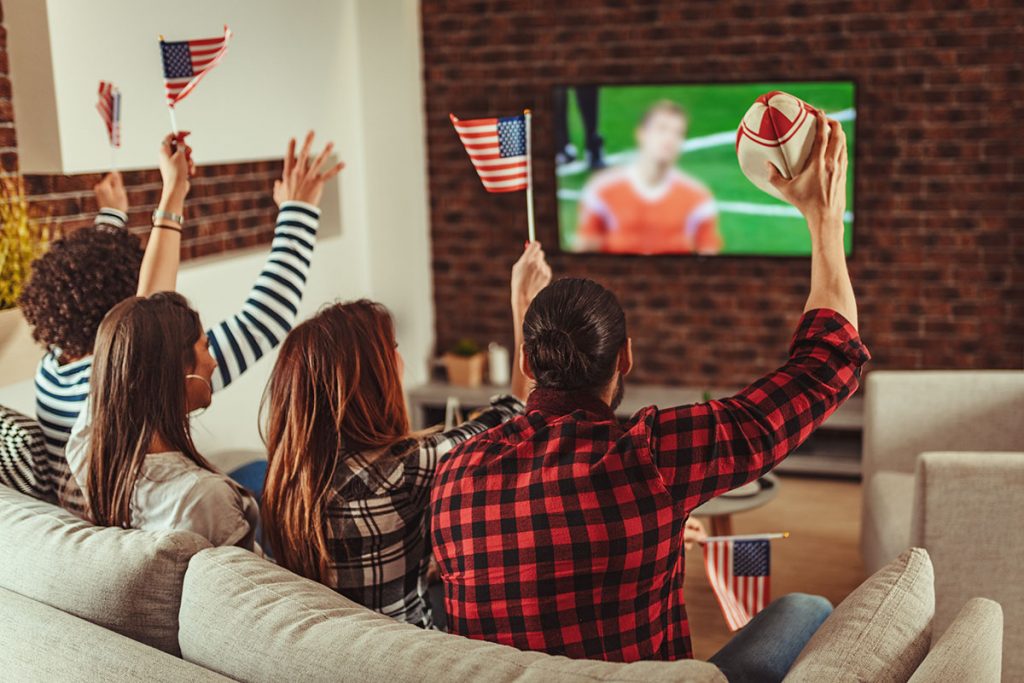
Shutterstock
Team Sport
CableLabs is proud to be part of the team that makes these voluntary agreement programs successful, saves consumers money, and continues to deliver innovative products and services. Customers across the U.S. and Canada cheered on their Olympic teams this year more efficiently, whether via an STB or streaming on a smart device.
The energy savings achieved aren’t just technical achievements; they’re like winning medals for the planet, helping to ensure that we pass the torch of a sustainable future to the next generation.
You can read more about energy efficiency on our blog and learn more about the voluntary agreements for the U.S. and Canada.
Energy
A Decade of Energy Savings
It’s been 10 years since the pay TV industry released the first report for the U.S. Set-Top Box Voluntary Agreement (STB VA), and the impressive energy savings continue! According to the most recent STB VA report covering the 2022 reporting period, the estimated national footprint of set-top boxes has dropped to 11.9 terawatt-hours per year (TWh/yr), all the way down from 32 TWh/yr in 2012!
Annual Energy Used by STBs in the United States
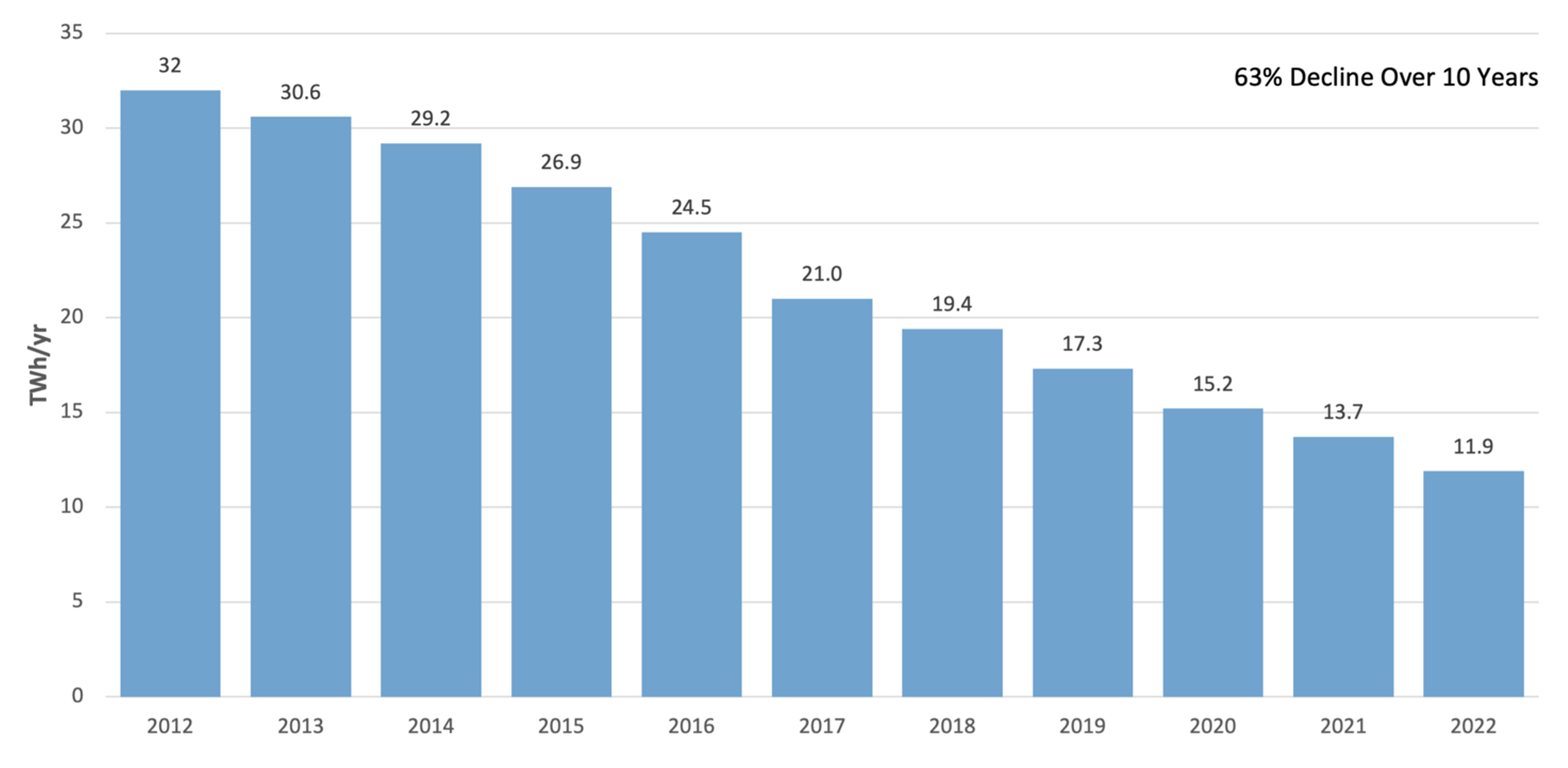
The 2022 savings equate to consumers saving more than $3 billion on their utility bills and avoiding over 14 million metric tons of CO2 emissions. In the 10 years of reporting, this adds up to $14.8 billion saved and 78 million metric tons of CO2 emissions avoided. That’s equal to the impact of removing 17.3 million gasoline-powered passenger vehicles from the road for a full year! (Reference: Greenhouse Gas Equivalencies Calculator)

Dogora Sun/Shutterstock.com
As the pay TV industry continues to migrate to more energy-efficient architectures and STB designs, including cloud DVR and small efficient IP-based set-top boxes, the average Typical Energy Consumption (TEC) of newly purchased STBs (weighted by quantities purchased of each model) also continues to trend downward. This data point is important because it reflects improvements that are independent of decreasing subscriber counts.
Average Weighted TEC of Purchased STBs by Year
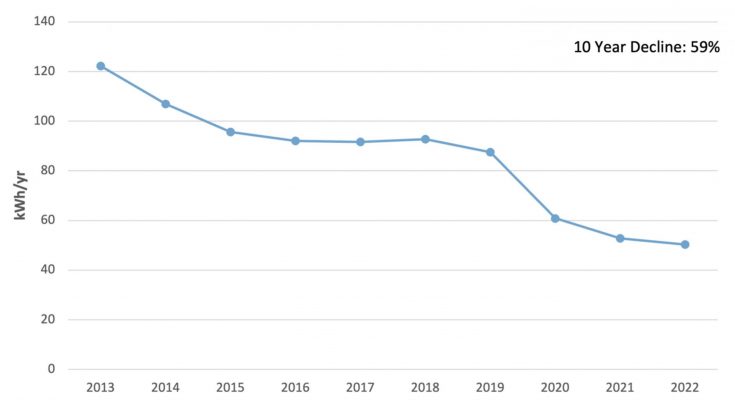
Small Network Equipment Voluntary Agreement (SNE VA)
The SNE VA has also been going strong since 2015, with seven years of reporting included in the recently released 2022 SNE VA Report. As shown in the chart below, the energy efficiency of new SNE purchases continues to improve.
Weighted Average Idle Power of New SNE Purchases Relative to Broadband Speeds
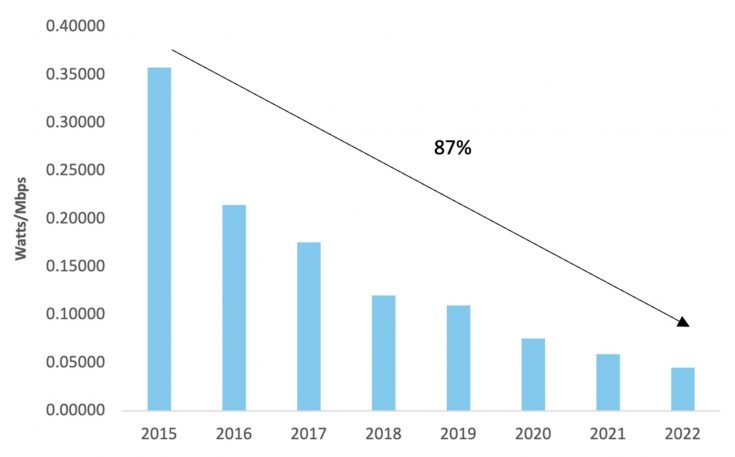
This trend is significant as the industry continues to roll out more capable equipment, supporting higher data rates, support for Wi-Fi 6 and 6E, and lower latency.
The SNE VA also expanded over this past year, adding several new signatories representing the retail market. In addition, the VA added Pacific Gas and Electric (PG&E) — the largest utility provider in California — as an energy efficiency advocate on the program. This is especially important to ensure that we remain aligned with the California Energy Commission’s objectives. The service provider and vendor representatives are depicted below.
SNE VA Signatories
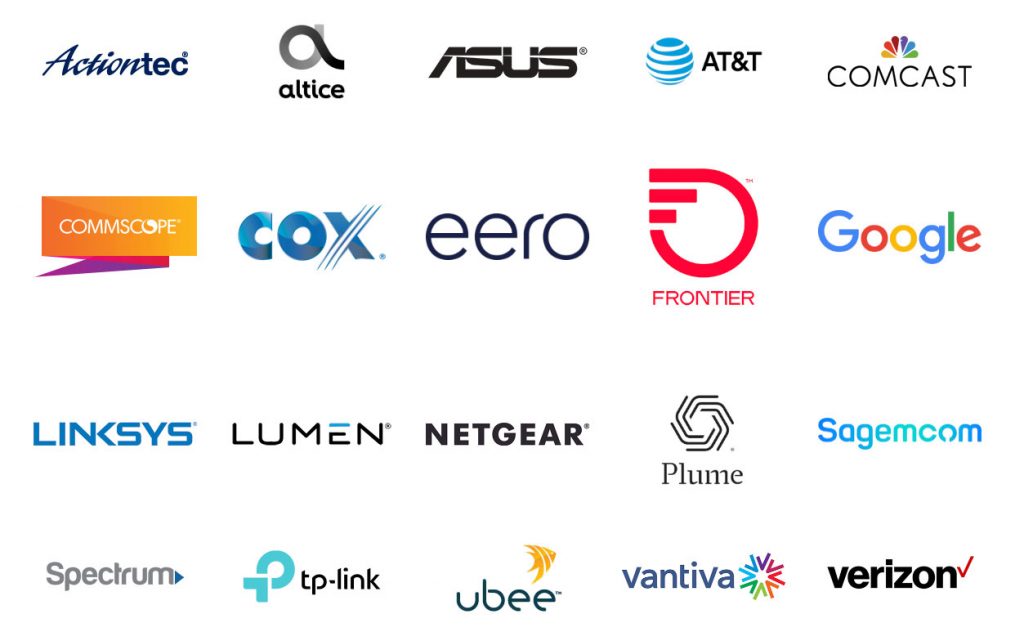
One of the important features of these voluntary agreements is their transparency. Every report released includes an appendix that lists details about each model of equipment that was reported, including its power consumption. The 2022 SNE VA report lists more than 400 unique models of residential network equipment purchased or sold through retail by signatories!
Canadian Energy Efficiency Voluntary Agreement (CEEVA)
And we can’t forget the great progress made by our Canadian partners in the voluntary agreement world! With six years of reporting on STB purchases, the CEEVA signatories have reduced the weighted average TEC of new STB purchases by 61 percent!
Average Weighted TEC of New STB Purchases
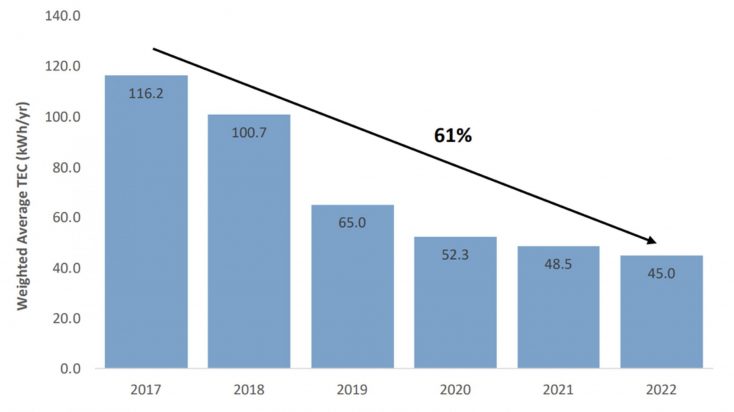
Only three years into CEEVA SNE reporting but already trending in the right direction, the CEEVA SNE report shows a 43 percent improvement in energy efficiency of new SNE purchased by the signatories.
Weighted Average Idle Power of New SNE Purchases Relative to Broadband Speeds
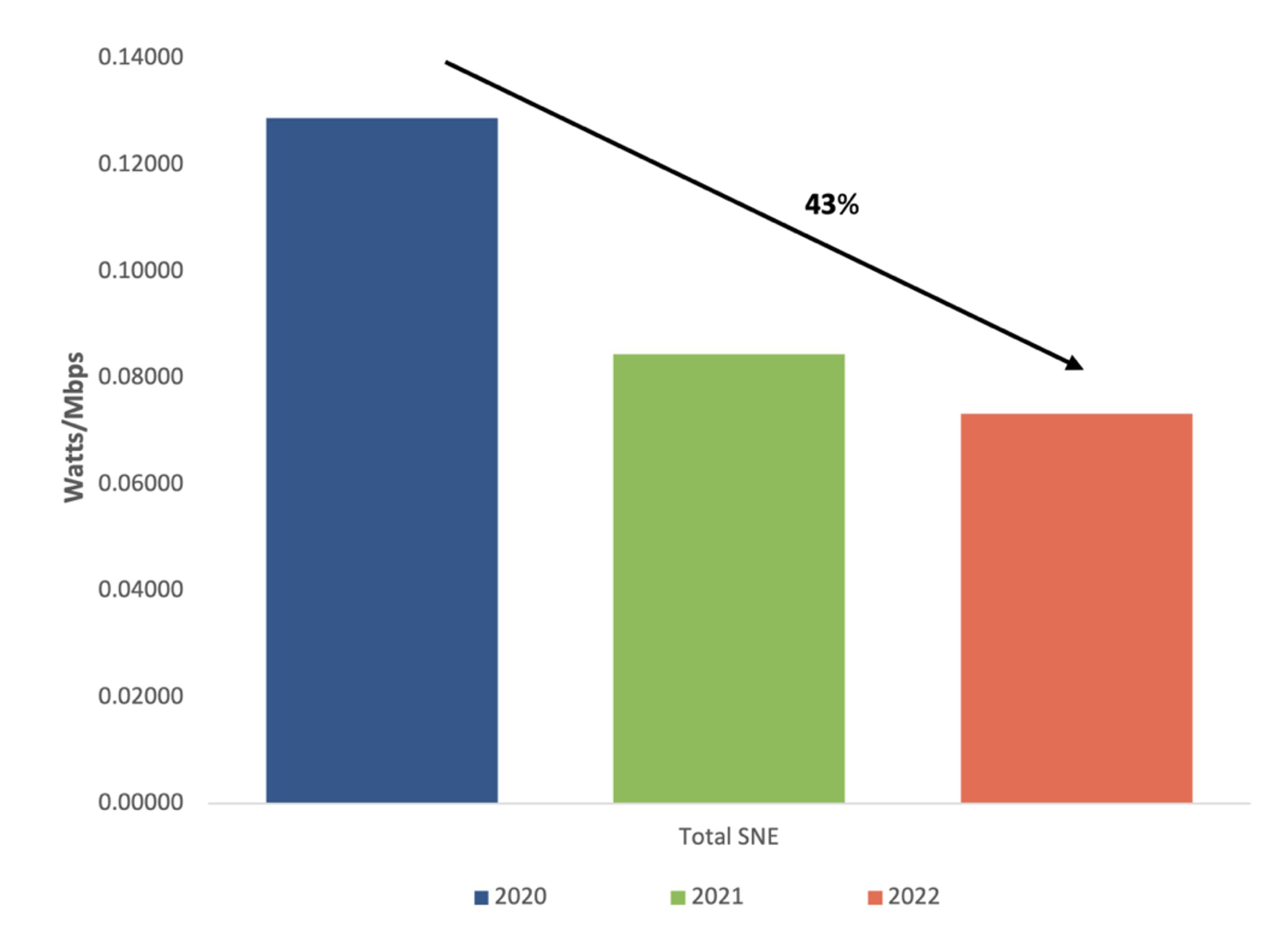
Environmental Impact Is Top of Mind
It feels as if climate change is on everyone’s mind these days, as the world experiences record heat waves, devastating wildfires and extreme weather patterns. The sense of urgency to reduce our environmental impact increases every day. CableLabs is proud to have led the technical efforts on these voluntary agreements since the beginning more than 10 years ago, and we’re only gaining momentum. The success of these voluntary agreements is a great example of how every little bit of savings can add up and make a big difference.
Learn more about the voluntary agreements! We invite you to attend a special session in the Innovation in Tech Policy track — entitled “Innovation in Energy Efficiency Policy” — on October 18 at SCTE® Cable-Tec Expo® in Denver. Also, visit the NEW Sustainability and Circularity Pavilion while at Expo!
You can read more about energy efficiency on our blog and learn more about the voluntary agreements for the U.S. and Canada.

Energy
A Ton of Savings—Thanks to Energy-Efficiency Voluntary Agreements

What weighs more, a ton of carbon dioxide gas or a ton of bricks? Well, that’s a trick question because they both weigh one ton! It’s difficult to imagine that a gas can be measured in terms of weight, but that’s how carbon dioxide, or CO2, is measured. CO2 is technically measured in terms of metric tons. One metric ton of CO2 would fill a cube roughly 27 feet tall, wide and deep!
In the U.S. Set-Top Box Voluntary Agreement (VA), we use the EPA greenhouse gas equivalencies calculator to quantify how many metric tons of CO2 are avoided, or saved, when we reduce the energy consumed by set-top boxes (STBs). The VA’s independent annual report was recently released, and the savings trends continue! D+R International reported that the voluntary agreement avoided 13 MILLION metric tons (MMT) of CO2 in 2021 alone and nearly 64 million metric tons in the nine years of the agreement!
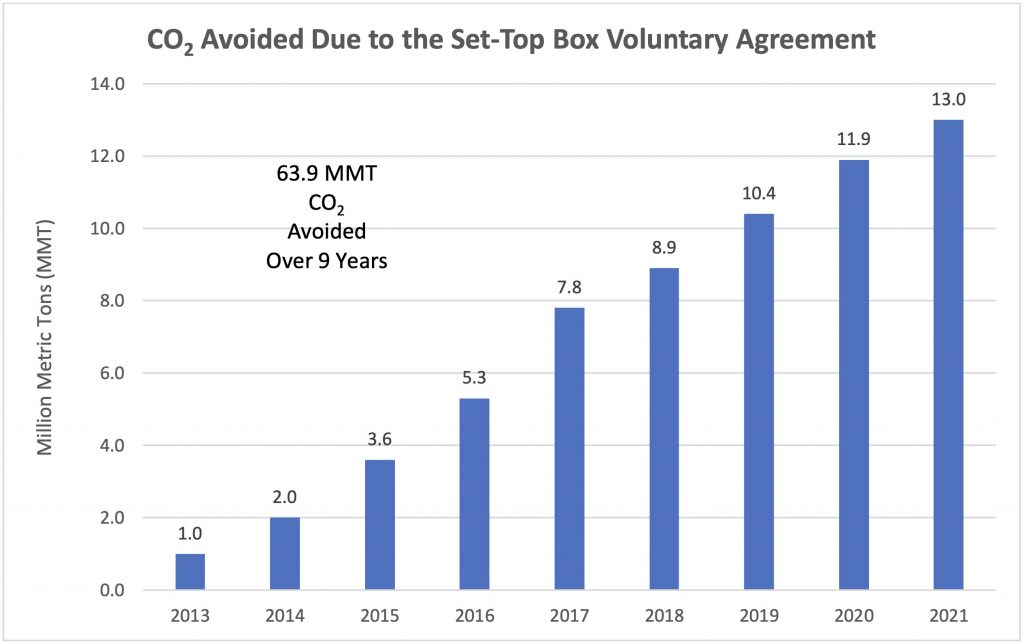
The chart below shows the impressive trend of reduced energy consumption over the nine years. This chart represents the estimated energy use of deployed STBs in the United States among cable, telco and satellite providers.
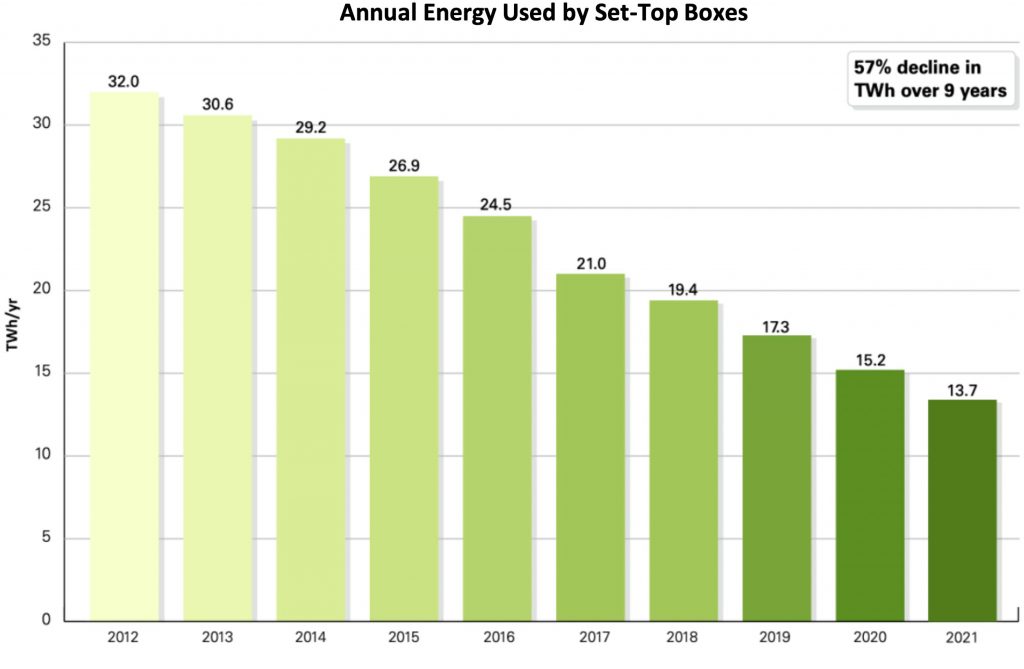
I will note that the number of deployed STBs has also declined, from an estimated 227 million in 2012 to 155 million in 2021. This is partly because of subscriber losses but is also attributed to whole-home DVR solutions and solutions to view pay TV content directly on TVs, phones, tablets, etc. (According to the report, an estimated 56 million devices accessed subscriber content through apps.) However, another interesting chart from the report shows that the average weighted typical energy consumption (TEC) of only the newly purchased STBs, as reported every year by the signatories, has also been reduced over the years by 57%. This is an important metric because it shows improvement without factoring in the smaller number of deployed STBs.
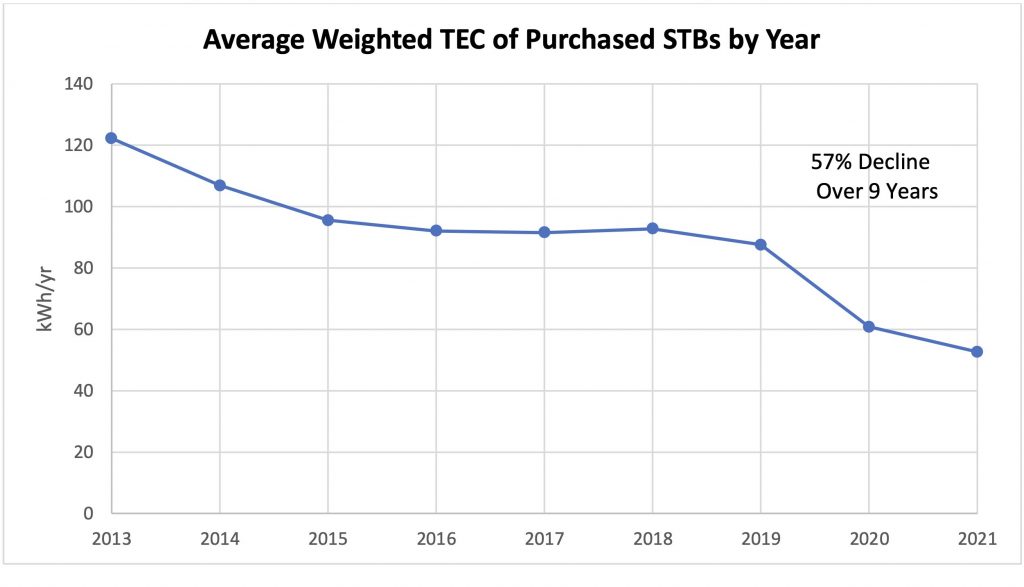
Small Network Equipment Energy Efficiency Gains
The 2021 Small Network Equipment Report was just released and also demonstrates continued energy efficiency trends even as the demand for faster and more capable broadband grows.
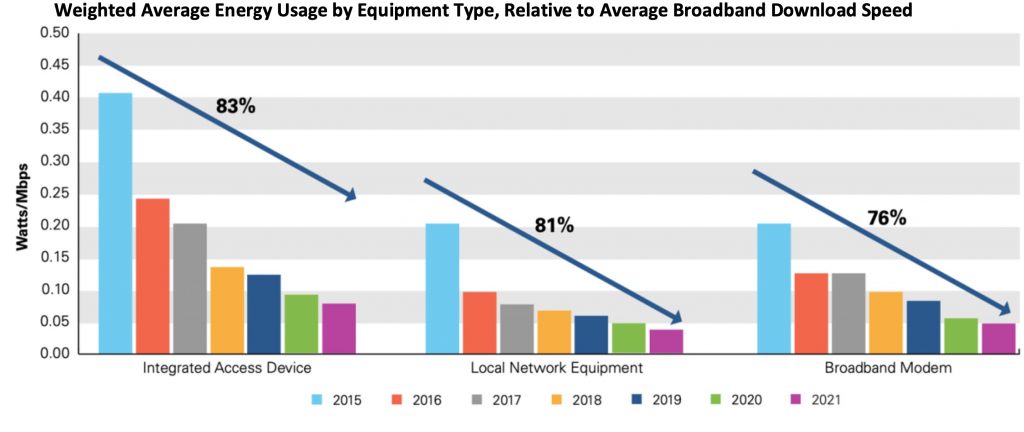
Canadian Energy Efficiency Voluntary Agreement (CEEVA)
Canada also has voluntary agreements for set-top boxes and small network equipment. CEEVA STB has been in place for five years and has demonstrated a very similar trend as the United States, as shown in the chart below. (Note: PVR stands for “personal video recorder,” which is called a “digital video recorder,” or DVR, in the United States.)
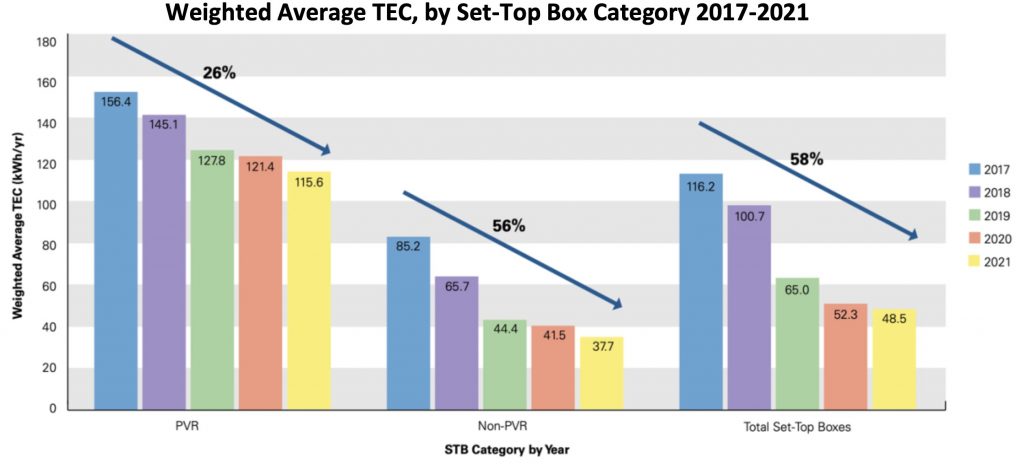
This is only the first year that SNE procurement commitments were in effect in Canada and just the second year to report purchases. Yet the results already show an exciting increase in energy efficiency—an improvement of 34% from 2020 to 2021!
Renewed Level of Commitment
Returning to the discussion of CO2, the cumulative impact of these programs is making a significant difference, and the programs are only gaining momentum. The U.S. SNE voluntary agreement has been renewed and extended through 2025 and has added several new signatories, including Google, Amazon eero, TP-Link and Sagemcom. In addition, California’s Pacific Gas and Electric Company has joined the SNE VA as an energy efficiency advocate. The U.S. STB voluntary agreement renewed its commitments last year to run through 2025, and Canada renewed both CEEVA STB and SNE to run through 2026. CableLabs is proud to help lead the charge to reduce the carbon contribution of STBs and SNE in North America while enabling the industry to continue innovating on the platforms.
Read more about energy efficiency on our blog, or click the button below to learn more about the cable industry's environmental sustainability initiatives.

Energy
U.S. Set-Top Box Voluntary Agreement Cuts Energy Use by 50 Percent

It’s that time of year again! The annual reports for the energy efficiency voluntary agreements (VAs) have been published. Every year, I think energy savings will plateau because it obviously takes some energy to power our set-top boxes and cable modems. Yet, once again, the annual reports have revealed another set of amazing accomplishments!
U.S. Set-Top Box Voluntary Agreement
The U.S. Set-Top Box Voluntary Agreement (STB VA) was established in 2012 with the goal of reducing the energy consumed by set-top boxes used for residential pay-TV service. At that time, energy efficiency advocates Natural Resources Defense Council (NRDC) and American Council for an Energy-Efficient Economy (ACEEE), along with pay-TV service providers from cable, satellite, and telco industries determined a baseline estimate of the annual energy consumed by all pay-TV set-top boxes in the United States. According to the report just published by D+R International, the independent administrator for the STB VA, the energy used by STBs in the United States has declined by over half from that baseline estimate!
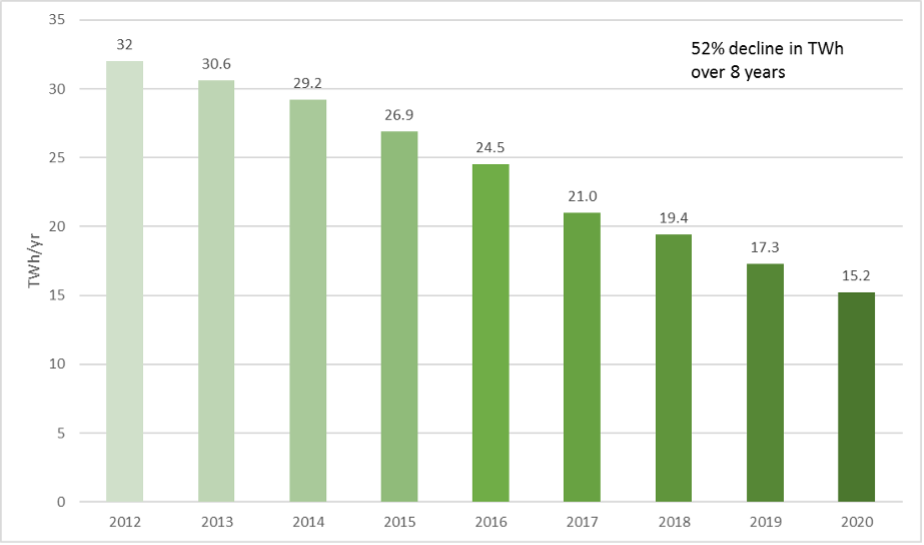
Estimated Annual Energy Used by Set-Top Boxes in the United States
This 16.8 TWh of savings in 2020 alone equates to over $2.2B in consumer savings and avoiding over 11.9 million Metric Tons (MMT) CO2. To put this into context, this savings in just 2020 is equivalent to the greenhouse gas emissions from nearly 2.6 million passenger vehicles driven for one year.

Add this up over the eight years of the VA, and consumers have saved nearly $9.3B and avoided 50.9 MMT CO2! That’s the equivalent of carbon sequestered by 842,539,644 trees!

Several factors have contributed to this substantial decline in STB energy use, including the deployment of whole-home digital video recorders (DVRs), migration of DVRs to the cloud and migration to Internet Protocol (IP) video with much-lower-power IP boxes, or no extra STBs at all. The STB VA Annual Report also found that more than 56 million unique customer-owned and -managed devices (including smart TVs, mobile phones, laptops and tablets) accessed video services during 2020.
This VA isn’t done yet! Earlier this year, the signatories, including NRDC and ACEEE, committed to renewing and extending the U.S. STB VA through 2025.
U.S. Small Network Equipment Voluntary Agreement
The U.S. Small Network Equipment VA (U.S. SNE VA) also continued to make strides during 2020, even as demands for greater speeds, better Wi-Fi and residential usage increased due to the pandemic. The 2020 annual report indicates that energy efficiency, as measured in watts per Mbps, has improved by 28 percent for integrated access devices (IADs) since 2019, and improved by 78 percent since the VA was established in 2015. IADs (modems with additional integrated features such as a Wi-Fi router and voice service support) made up nearly 66 percent of the purchases in 2020.
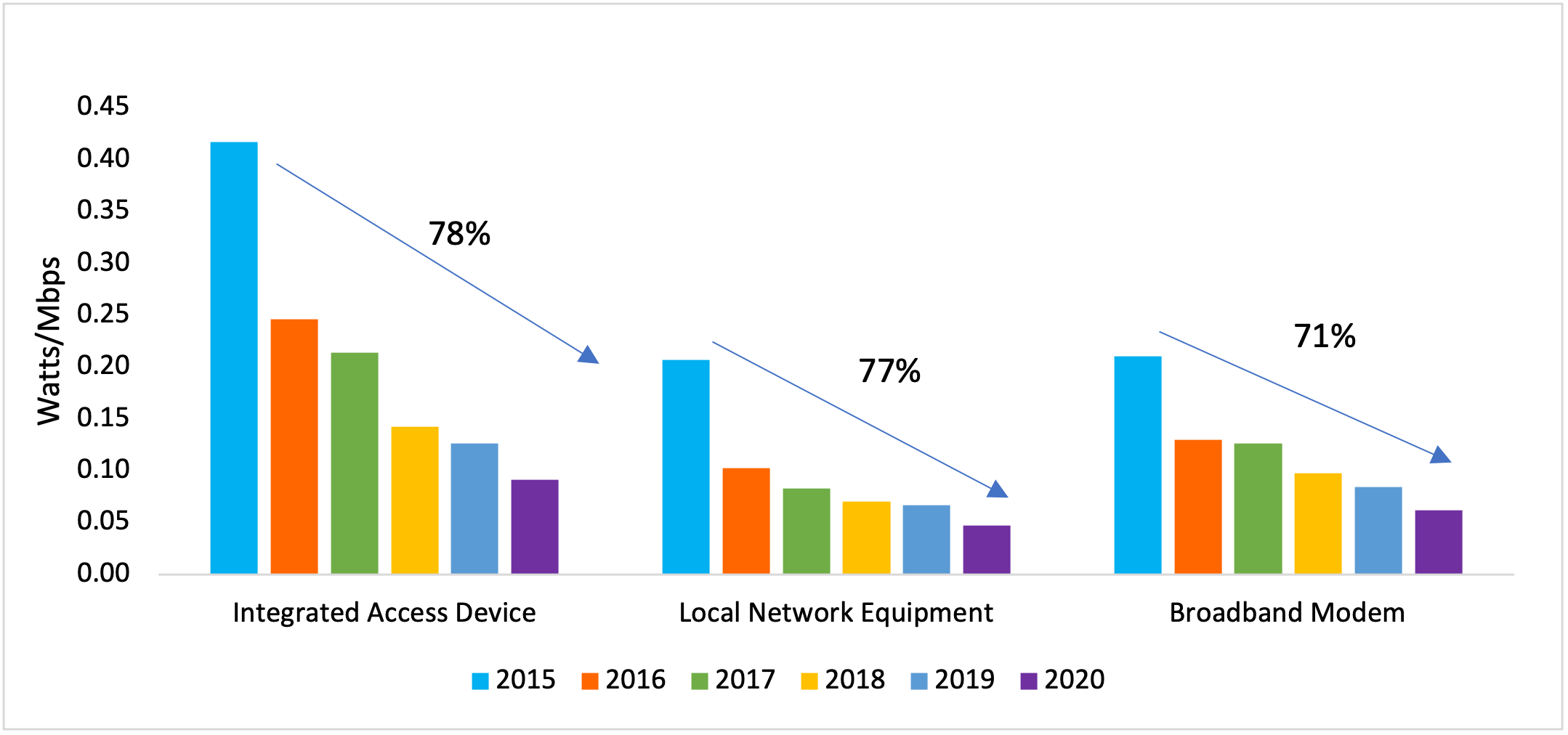
Average Energy Usage by Equipment Type, Weighted by Broadband Speed
The U.S. SNE VA is also scheduled to expire this year, and CableLabs is leading a team of signatories and equipment providers to define the next tier of allowances and terms to renew and extend this VA as well.
Canadian Energy Efficiency Voluntary Agreement
Efforts north of the border are also impressive. In the most recent report from the Canadian Energy Efficiency Voluntary Agreement (CEEVA) STB program, the weighted average typical energy consumption (TEC) of STBs purchased in 2020 declined yet again and has already dropped 55 percent since the program began in 2017. Much like the United States, Canada is also trending toward lower-power IP and thin-client STBs, which is contributing to this continued energy savings year over year.
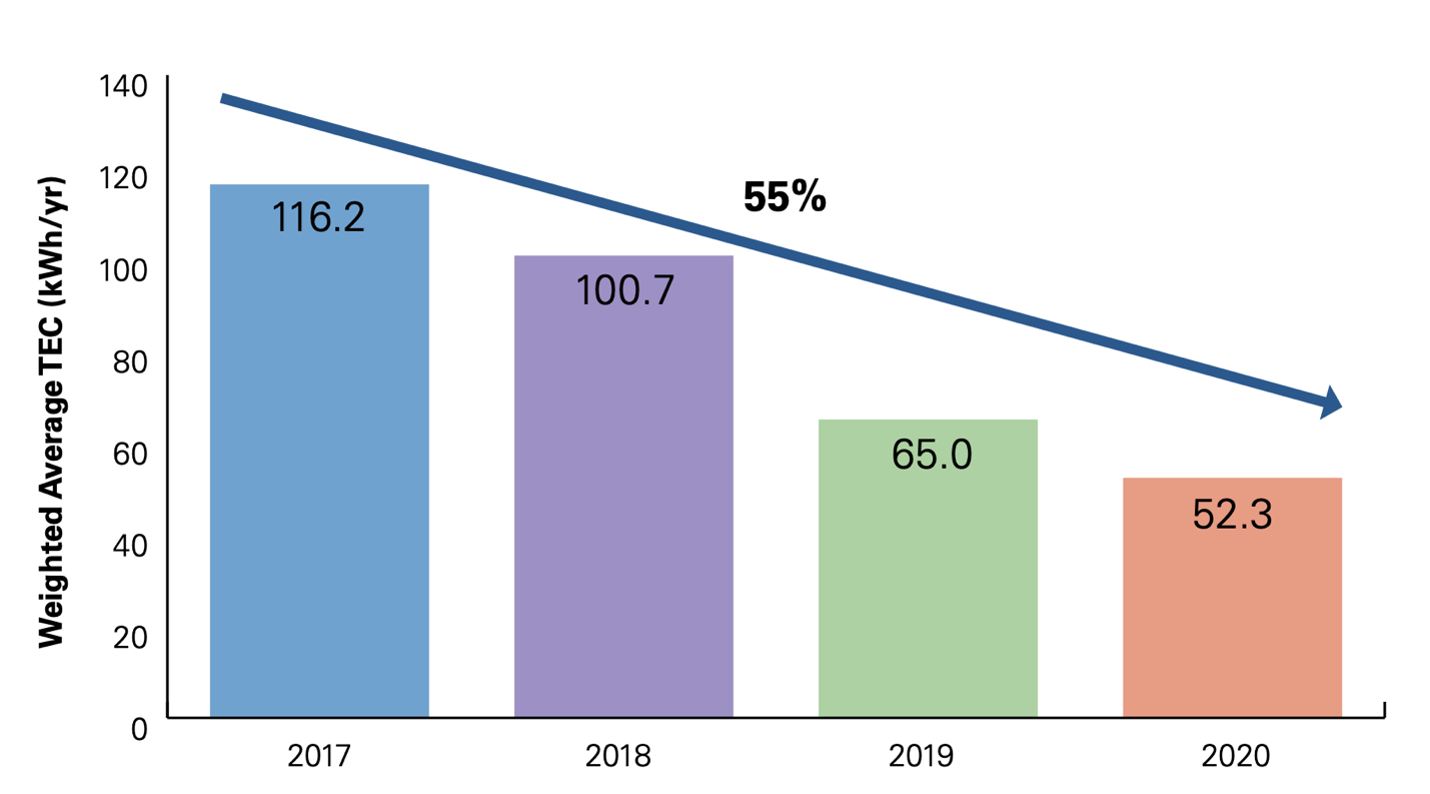
Weighted Average TEC of STB Purchases Under the CEEVA STB Program by Year
This is also the first year that the new CEEVA report includes the SNE program in Canada, and the report found that 100 percent of the service provider SNE purchases met the CEEVA SNE Tier 2 levels.
Conclusion
Programs such as these VAs are more important than ever before, especially in light of the recent United Nations report on climate change. As an increased global emphasis is placed on energy efficiency, these voluntary programs are demonstrating how incremental steps toward saving power can add up and make a difference. And the VAs continue to enable innovation in this rapidly changing market, leading to more exciting products and services. CableLabs is proud to be a key industry partner in the continued success of these voluntary agreements.

Energy
Set-Top Box Voluntary Agreement Tightens Energy Allowances and Extends Term

CableLabs, CTA and NCTA are pleased to announce that the award-winning Set-Top Box Voluntary Agreement (STB VA) has been extended by four years, along with introducing a new tier of allowances that will reduce energy consumption of set-top boxes by at least another 20 percent.
The STB VA has been a true success story since it was established in 2012. In the first seven reporting years, the STB VA has saved U.S. residential video consumers a total of 55.1 TWh and over $7 billion in electricity bills. More important, it has averted nearly 39 million metric tons of CO2 emissions through 2019.
Since the inception of the STB VA, the average energy consumption of set-top boxes has steadily declined, even as set-top box features have increased, such as 4K video support, Wi-Fi interfaces and the ability to record multiple programs at the same time. This progress demonstrates the successful collaboration between everyone in the ecosystem, including silicon manufacturers, equipment manufacturers, software developers, service providers, and energy-efficiency advocates. It is projected that, at the end of this extended term, the total energy used by set-top boxes in the United States will be only one-third of the energy used by set-top boxes in 2012 when the agreement was initially signed!
The charts below depict the evolution of a typical cable set-top box without a digital video recorder (Non-DVR) and one with a digital video recorder (DVR) across the years and across the tiers. Note that non-DVR energy consumption has decreased by nearly 70 percent between Tier 1 and Tier 4. This is especially significant as operators migrate more toward non-DVR smaller-client set-top boxes and use their ability to maintain customers’ recordings in the cloud. Not only does this capability dramatically reduce the energy footprint of STBs in the home, but it also enables customers to watch their recordings on their phones, tablets, PCs and other devices inside and outside the home.

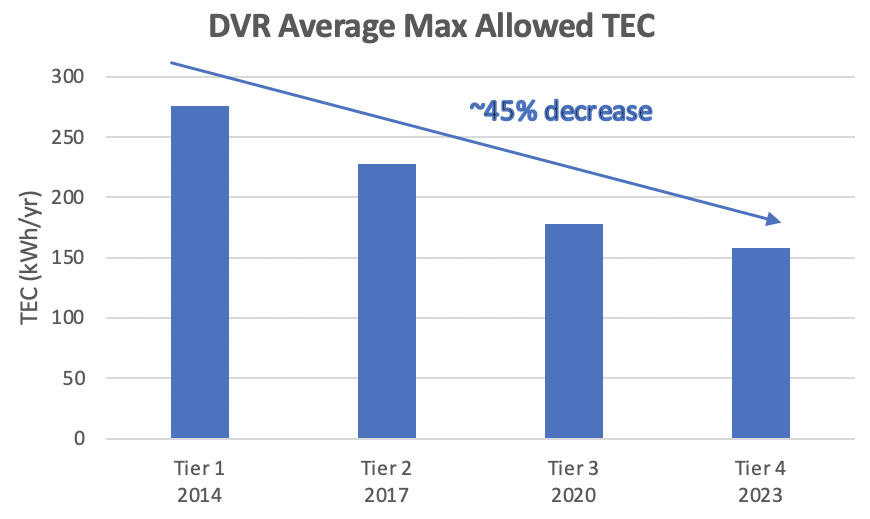
History of the STB VA Tiers
In 2012, the STB VA was developed as a result of discussions among pay-TV service providers, technology suppliers, energy-efficiency advocates and the U.S. Department of Energy. The industry VA was forged, and it has certainly demonstrated that it is an effective alternative to regulation since its inception.
One of the primary commitments of the STB VA is that 90 percent of all STB purchases in a calendar year will measure in lower than the energy-consumption levels specified by the applicable tier. When the STB VA was established by the industry in 2012, the first tier adopted the same levels as the ENERGY STAR 3.0 program that was currently in place for STBs. That defined the “Tier 1” set of allowances for the STB VA.
In 2013, two energy-efficiency advocates—the Natural Resources Defense Council and the American Council for an Energy-Efficient Economy (ACEEE)—became signatories as part of an extension to the VA that included a more aggressive new “Tier 2” set of allowances, which became applicable in 2017.
The VA was extended a second time in 2018 with a new Tier 3 definition of allowances and the term running through 2021. At the time Tier 3 was defined, the signatories also committed to exploring a Tier 4 for the allowances.
That brings us to today. After several years of research and industry collaboration led by CableLabs, the signatories just ratified a new amendment to the VA, extending the term through 2025 (with a final report in 2026) and defining an even more aggressive Tier 4 set of allowances.

To Sum It Up
In the Tier 1 era, near the beginning of the VA in 2013, a typical cable customer had two DVRs and one non-DVR device because set-top boxes were not yet networked in the home. Heading into the Tier 4 era, that same cable customer will have even more features and capabilities (e.g., cloud recording, 4K video, integrated streaming services such as Netflix) but may have just three small non-DVR devices, reducing set-top box energy consumption in the home by over 80 percent!
CableLabs is proud to be part of this highly successful VA that affords new innovative features, greater functionality and the capability to deliver high-quality services to consumers in an energy-efficient manner.
Want to Learn More?
- Read the Inform[ed] Insights Paper
- Visit the U.S. Voluntary Agreement Website

Energy
Energy Efficiency Voluntary Agreements Helped Pave the Way for Increased Remote Access
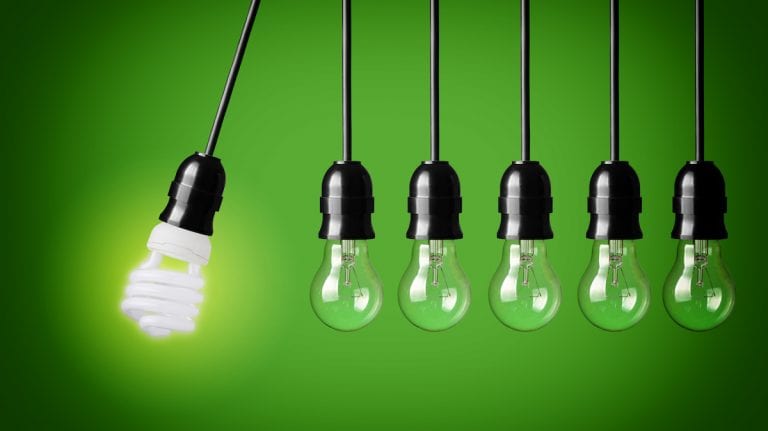
We’re enduring crazy times in 2020! Because of COVID-19, the world has shifted to learning, working and playing at home for months at a time—and residential cable networks have successfully handled the load. One key reason that networks have managed so well is because cable service providers build for the future: The majority of cable networks were well-positioned to deliver the necessary downstream and upstream data to customers who are now conducting much of their day remotely over the network.
How do energy efficiency voluntary agreements play a role? One major advantage to the voluntary approach is the New Feature Allowances Process, which enables operators and manufacturers to innovate and evolve their networks and consumer devices without being constrained by regulation. An example is the Small Network Equipment Voluntary Agreement (SNE VA) adopted by the United States in 2015 (Canada also established a similar agreement late last year). In the 4 years that the SNE VA has been in place, average broadband download speeds have nearly quadrupled and consumer devices have evolved significantly, such as cable modems migrating from DOCSIS 3.0 to 3.1 to deliver faster download speeds. In addition, Wi-Fi devices have evolved to use more radios with more spatial streams and capabilities to deliver increased Wi-Fi capacity within the home. The New Feature Allowances Process provides the ability to define new features that may require additional power, which—in the case of small network equipment—allowed operators to roll out devices early to meet the increased demand due to COVID-19 when consumers needed it the most.
And, according to the recently released US SNE VA annual report, the energy consumption of these devices has remained stable, as demonstrated in the figure below.

In fact, the independent administrator for the voluntary agreements, D+R International, reported that the energy efficiency[1] of integrated access devices (modems with Wi-Fi routers and/or embedded phone support) has improved by 70 percent since the beginning of the SNE VA in 2015.
The US SNE VA was also recognized by the Global Commission For Urgent Action on Energy Efficiency as an “Exemplar Policy” program in this recent report.
U.S. Set-Top Box Voluntary Agreement (US STB VA)
The US STB VA report also shared good news, finding that the national set-top box annual energy consumption has declined by 46 percent since the beginning of the VA in 2012, even as functionality and features of set-top boxes have improved.

The STB VA saved 14.7 TWh in 2019, which is nearly equivalent to the power generated by five coal-run power plants in a year, and saved consumers over $1.9 billion on their utility bills. This is enough electricity to power ALL the homes in California for a full 7 months!

Canadian Energy Efficiency Voluntary Agreement (CEEVA)
Even though CEEVA has been around for only 3 years, Canada is making great strides as well, as detailed in its most recent CEEVA Annual Report. The average weighted energy consumption of purchased set-top boxes has decreased by 44 percent over the 3 years that CEEVA has been in place. This significant decline is due to a number of reasons:
- Deployment of whole-home architectures that enable customers to view recorded content throughout the home with just one personal video recorder (PVR)
- Deployment of cloud-based recording that eliminates the need for any PVR in the home, and PVRs generally consume more power than non-PVRs
- Improvement in set-top box energy efficiency

As we reported in December 2019, Canada stood up a new CEEVA agreement for small network equipment that went into effect in 2020, but the first report won’t be out until next year.
CableLabs is proud to be part of these highly successful voluntary agreements that afford new innovative features, greater functionality and the capability to deliver high-quality services to consumers in an energy-efficient manner.
[1] Energy efficiency of network equipment is measured in terms of energy per consumed bit. In the US SNE VA report, the unit of measure is Watts/Mbps.

Energy
Canada Launches a Small Network Equipment Voluntary Agreement

CableLabs is pleased to announce that an energy efficiency voluntary agreement for Small Network Equipment (SNE) was launched today in Canada. This is the second category of equipment in the Canadian Energy Efficiency Voluntary Agreement (CEEVA) program, which was initiated in 2017 to improve the energy efficiency of Set-Top Boxes (STB).
The new CEEVA SNE, which was developed in partnership with Natural Resources Canada (NRCan), provincial governments and utilities, commits leading service providers and manufacturers to improving the energy efficiency of devices like Internet modems and routers by 2021. It is based on the highly successful SNE Voluntary Agreement in the US that was established in 2015 and has achieved an average 66 percent improvement in energy efficiency of the SNE purchased and deployed by its signatories since its launch.
The CEEVA SNE signatories to date are:
- Bell Canada
- COGECO Connexion Inc.
- CommScope, Inc. of North Carolina
- Rogers Communications Canada Inc.
- Shaw Communications Inc.
- Vidéotron LTD
- Technicolor Connected Home USA LLC
In CEEVA SNE, the service providers commit that 90 percent of their new SNE purchased will meet the energy efficiency levels beginning in 2021. The levels will align with the more rigorous Tier 2 levels that were established in the US SNE VA when it was extended last year, so Canada is skipping Tier 1 and going right to Tier 2. (In the US, Tier 2 will go into effect in 2020.) As with CEEVA STB, compliance is determined through independent testing and auditing, and the service providers will also publicly post the power consumption of all models purchased after January 1, 2020.
Programs such as CEEVA and the US Voluntary Agreements are very important to keep energy efficiency a design priority, yet provide the agility required to rapidly innovate on these platforms. A voluntary approach to improve energy efficiency has been proven to be an effective alternative to regulation. This is even more important as we head into a 10G world.
Four of the five CEEVA service provider signatories are cable operators and CableLabs members, and CableLabs provides significant leadership in the CEEVA program. In addition, Kyrio is ISO-17025 accredited to conduct the energy testing for set-top boxes and small network equipment, and supports the CEEVA signatories with their testing expertise.
Internet services provided by the CEEVA signatories also help to save energy by enabling e-commerce, telecommuting, smart thermostats and lighting. By standing up this new voluntary agreement, these companies are further advancing their commitments to Canada’s shared energy efficiency and climate change objectives.

Innovation
Immersive Media Experiences Reaches New Milestones
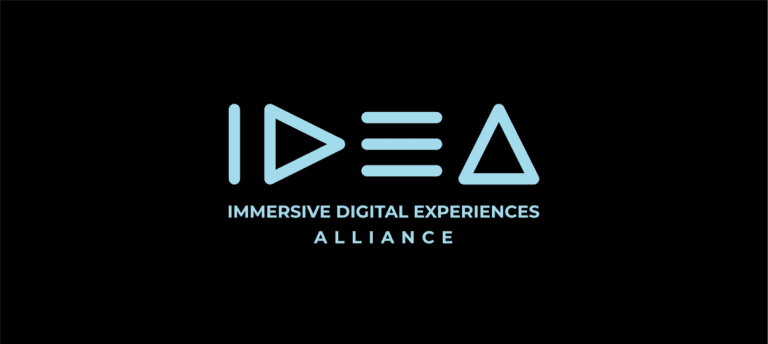
In April this year, CableLabs joined Charter Communications, Light Field Lab, OTOY, Visby, and Cox Communications to establish the Immersive Media Experiences Alliance™ (IDEA). The primary purpose of this endeavor is to develop a set of royalty-free standard specifications for immersive media formatting and distribution. This month, several significant milestones were achieved:
- IDEA released its first set of draft specifications for public review,
- CableLabs hosted the Light Field and Holographic Display Summit, and
- IDEA demonstrated the first Immersive Technology Media Format™ (ITMF) content across multiple display types
IDEA Releases Draft Specifications
Based on OTOY’s ORBX format, the Immersive Technology Media Forma (ITMF) is a display-agnostic interchange format for conveying light field imagery to a variety of display types, including light field displays. IDEA has released three draft specifications so far to document this media format: the Scene Graph Specification, the Container Specification and the Data Encoding Specification. As noted, these are draft specifications and there is still work to do in the areas of display profiles, live action capture and representation, as well as media-aware network streaming. We encourage interested stakeholders to join IDEA and help shape the future of immersive media.
CableLabs Hosts the Light Field and Holographic Display Summit
This year’s Light Field and Holographic Display Summit, produced by Insight Media, was hosted by CableLabs in Louisville, Colorado in early October. The two-day event covered not only display technology but the entire light field and holographic ecosystem. CableLabs, as a founding member of IDEA, is very interested in facilitating the acceleration of this ecosystem and envisions the 10G cable network technologies will enable the delivery of holographic experiences to consumer’s homes.
The agenda was full of many interesting sessions and thought-provoking panels representing 22 different companies in this space, including talks from these IDEA founders:
- Pete Lude, Chairman of IDEA and CableLabs IDEA Board Director, provided an overview of Light Field Immersive Media and an introduction to the Immersive Digital Experiences Alliance.
- Jon Karafin, CEO of Light Field Lab, presented an overview of the latest developments in light field display technologies.
- Ryan Damm, CEO of Visby, discussed how to get real-world footage onto these next-gen displays.
- Jules Urbach, CEO of OTOY, addressed synthetic media development and formats.
- Curtis Knittle, VP of Wired Technologies at CableLabs, discussed how cable 10G networks are evolving to carry light field data.
The takeaway from the summit was that there is significant activity, interest, and exciting developments in this space, both for commercial as well as military applications. As we heard Tony Werner, President of Comcast, exclaim during the most recent SCTE CableTec Expo General Session, “Holographic displays are coming sooner than we may think”! Comcast, along with Liberty Global Ventures, Samsung, Verizon Ventures, and others were recently part of a $28 million round of funding raised by Light Field Lab.
IDEA Demonstrates First ITMF Content Across Multiple Display Types
One of the main objectives of the IDEA Immersive Technology Media Format (ITMF) is to make it display-agnostic so that it can be created and stored in one format and rendered out to support multiple types of displays, including traditional 2D flat panels, virtual reality head-mounted displays, and glasses-free light field displays. Only months after IDEA was launched, members of IDEA demonstrated this concept with content created in the ITMF format and played out on an Oculus Go VR headset, a standard 2D television, and a 3D TV with active glasses.
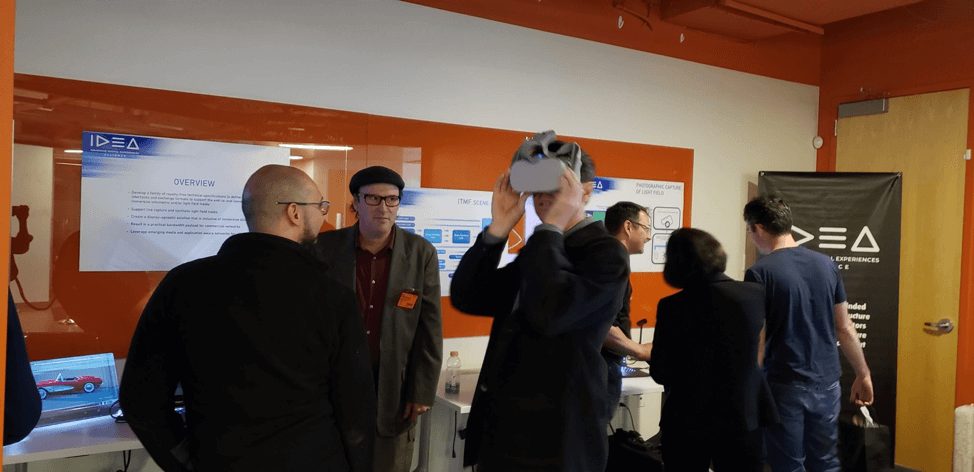
Although the Immersive Digital Experiences Alliance has only been established for a few months, these milestones demonstrate exciting progress in this space. And the alliance is just getting started! IDEA welcomes service providers, content producers, technologists and creative visionaries to join IDEA and define the media and distribution formats of the future.

Energy
Voluntary Agreements Continue to Save Money and the Environment

Last week, three important energy efficiency annual reports were released and the results are remarkable. I’m talking about the award-winning Set-top Box (STB) and Small Network Equipment (SNE) Voluntary Agreements (VA) in the United States, and the Canadian Energy Efficiency Voluntary Agreement for Set-top Boxes (CEEVA). These three programs were established in the U.S. and Canada with the goals of making set-top boxes and residential equipment more energy efficient, saving consumers money and reducing carbon emissions from power plants, all while continuing to innovate and introduce new features.
United States Set-top Box Voluntary Agreement
The US STB VA, established in 2012, expanded in 2013, and renewed in 2018, covers over 94% of the pay television market in the United States. Over the six years of this VA, the signatories continue to find ways to deliver services more efficiently. In the most recent 2018 Annual Report, the independent administrator, D+R International, found that the STB VA reduced the national STB energy consumption from 32 TWh in 2012 to only 19.4 TWh in 2018.
 Consumer Savings
Consumer Savings
• $1.6 BILLION in 2018
• $5.15 BILLION total in 6 years
Carbon Footprint
• 8.9 Million Metric Tons CO2 emissions avoided in 2018
• 28.6 Million Metric Tons CO2 emissions avoided in 6 years
United States Small Network Equipment Voluntary Agreement
The US SNE VA report shared impressive results as well with energy efficiency continuing to improve year over year, demonstrating an average of a 66% decline in energy usage relative to increasing broadband speeds over the four years of the VA. This is especially impressive considering that the operators are purchasing and deploying devices to support continued demands on bandwidth and capabilities. When the SNE VA was established in 2015, the cable service providers reported sixteen different DOCSIS 3.0 models with only eight downstream bonded channels and no DOCSIS 3.1 purchases. In 2018, the only DOCSIS 3.0 models reported were at least 16 downstream bonded channels and ten different DOCSIS 3.1 models were reported.
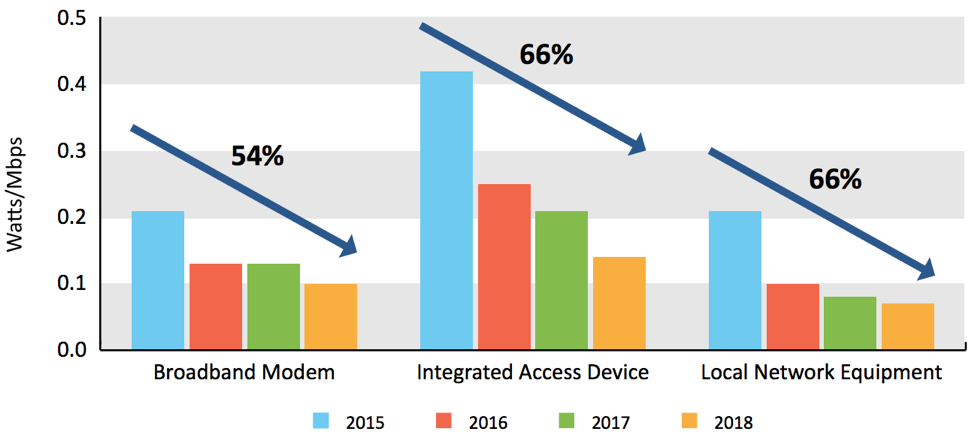
Figure 2 US SNE VA Average Energy Usage by Equipment Type, Weighted by Broadband Speed
The US SNE VA was recognized this year by Environmental Leader as a 2019 Top Project of the Year
Canadian Energy Efficiency Voluntary Agreement
CEEVA is only in its second year of reporting but is already demonstrating significant results. You can find the annual report here, and it is also available in French here (pour tous ceux qui veulent lire le rapport en Français!)
Figure 3 Weighted Average TEC, by Set-Top Box Category
CableLabs’ Role
Although CableLabs is not an official signatory to these voluntary agreements, we play a critical role in their success in a number of areas:
- Leading the technical working groups for all of the VAs, researching and innovating ways to further reduce energy consumption in the devices
- Playing a key role in the negotiations when establishing, running and renewing the VAs
- Chairing the CTA R04WG13 working group that is responsible for the STB energy consumption test procedure used by the US STB VA, CEEVA and ENERGY STAR
- Conducting energy testing for most major cable signatories in the U.S. and Canada (CableLabs and Kyrio are both ISO-17025 accredited for energy testing of STBs and SNE)
The success of these agreements continues to reinforce the benefits of a voluntary approach to achieve these goals over more restrictive government regulation. In this market, where technology is evolving at an increasingly rapid pace, these agreements provide CableLabs members and partnering vendors the opportunity to innovate and deliver the services that our consumers demand.
We are extremely proud of the success of these voluntary agreements and the positive impact they have had on cable consumers and the environment.
Want to Learn More?
- Read the Inform[ed] Insights Paper
- Read more blogs on this topic




